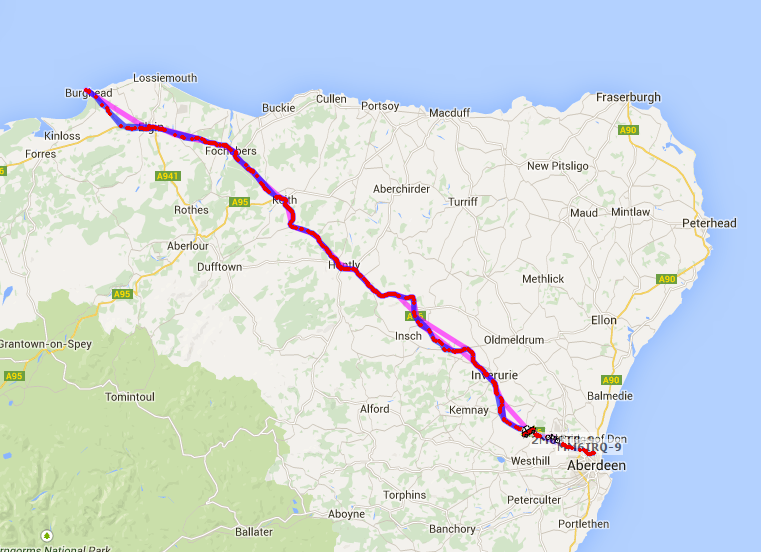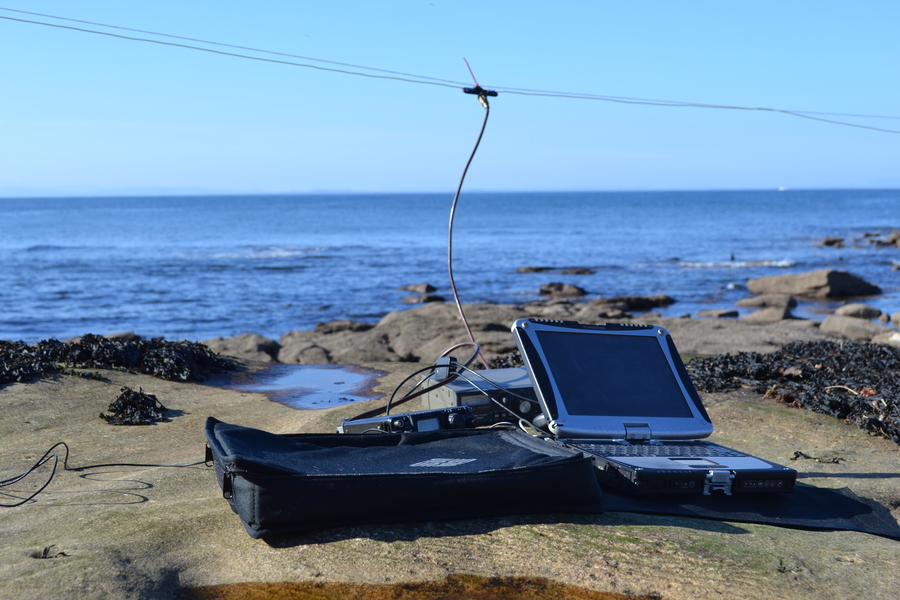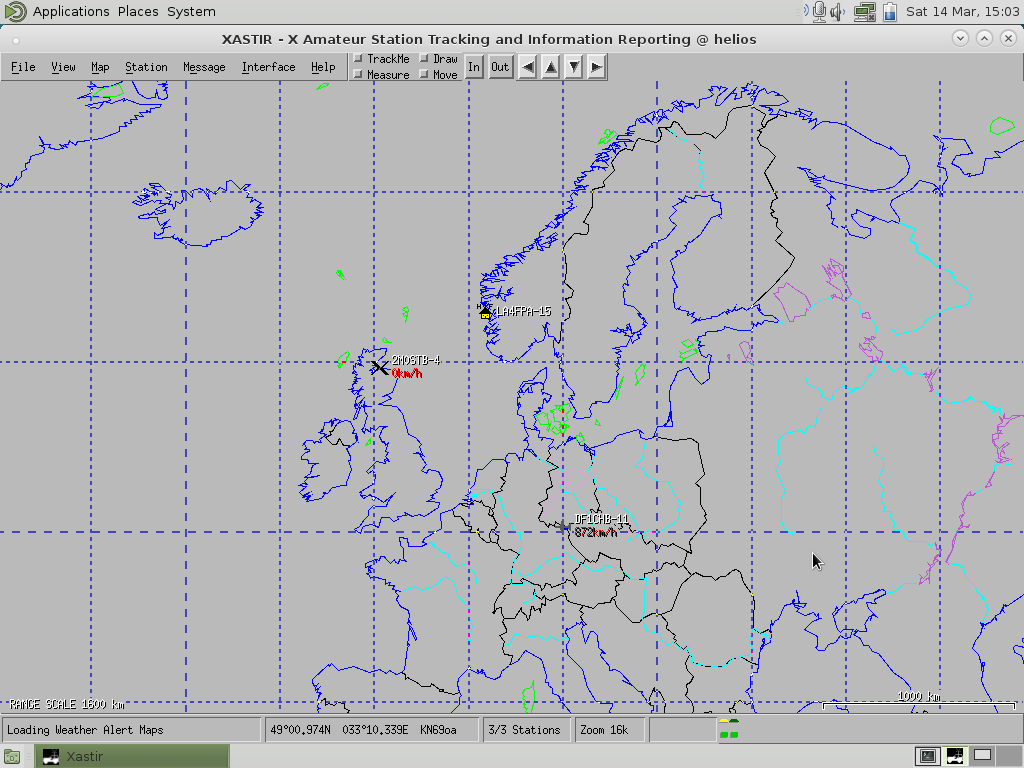APRS on HF
Published:
On Thursday, an email appeared on the hackerspace mailing list proposing an adventure to a distant land where we would operate portable amateur radio stations. Today I went on an adventure to Burghead, a place by the sea approximately 64 miles on a bearing of 305° from my home in Aberdeen. The group embarking on this adventure included Hibby MM3ZRZ, Tom MM6IRQ, Ed MM6MVP and Derecho PA1XOR. We travelled by car and beaconed our journey with APRS-IS on the way.

The track recorded on aprs.fi
Without making any consideration for the weather when choosing the day for this adventure, we found ourselves to be lucky with temperatures reaching 8°C according to the dashboard in Ed’s car. Even if none of our radio projects worked, it was still a lovely day at the beach.

Tom and Hibby setting up a dipole
I have recently been playing with APRS on VHF and looking at getting a digipeater set up. I knew that APRS operation happened on HF, but I’d never really looked at it. Today I wanted to finally look.
It wasn’t easy to find the information I needed to get started. Even just working out the frequency I should be using was a pain, with nothing to go on at first but a very confusing table. Eventually though I found this page about APRS on HF and it cleared up a lot of the confusion.
Some important things to note:
- NRZI coding is used, so it does not matter which way round the tones are. This allows you to use both USB and LSB with your TNC depending on what you have available.
- However you get there, the frequencies for the tones for APRS on HF should be 10.149.200 MHz and 10.149 400 MHz.
As I at least knew I was going to be in the 30 meter band, a rather quiet band limited to only CW and narrowband data modes due to its small size, I began by constructing a 30 meter dipole and setting it up on the beach along with my FT-817ND connected to my “radio field day” Panasonic Toughbook (running Debian of course).

The portable setup
I used Dire Wolf as my TNC and Xastir to perform mapping of the received packets and to attempt to send my own.
Recieving Packets
Before considering sending any packets, I wanted to make sure I could receive packets to ensure my frequencies were correct. My plan was to use 1600/1800Hz tones and set the dial frequency to 10.147.600 MHz using USB and this would give me tones I was looking for.
It turns out that with Dire Wolf, this is as simple as:
MODEM 300 1600 1800
If you have a line in your config file, which if you’re using the example config file as a base you will have, that reads:
MODEM 1200 1200 2200
You should comment this out by placing a # at the start of the line as this
may confuse Dire Wolf.
From Dire Wolf 1.1, there is a feature that allows you to have multiple demodulators at offsets from the tones you’ve specified to allow for extra tolerance in decoding packets from stations that are not precisely tuned. At first I tried using this feature as I thought it would help me to decode packets but the poor Toughbook struggled with the extra CPU load and this caused me to not decode a single packet while I had this feature in use.
With Xastir connected to Dire Wolf, I was able to decode and place on a map two stations, which I was quite pleased with:

Screenshot of Xastir showing received stations
I was very happy to see my first data packet from a /AM station, DF1CHB was on-the-air in-the-air.
If you’d like to have a go at decoding some 300 baud packets, I recorded just over half an hour of audio with the dial set to 10.147.600 MHz using USB. You can download this as a FLAC file: hf-aprs.flac (126MB).
Sending Packets
Once Dire Wolf was set up to recieve packets, there was not much to do to start sending packets in Dire Wolf other than to enable the PTT. The rest of the configuration was done in Xastir.
As I didn’t want my HF packets to be overwritten if I did manage to hit an IGate, I used SSID -4 which I haven’t used before. I think I’ll be using -4 for all future HF APRS activity. I also changed the path from WIDE2-2 (the default Xastir path) to GATE. My hope was to be able to reach an IGate and if an HF station was able to hear me, but not able to send my report to APRS-IS, then hopefully it could get my packet via VHF to another station that could IGate me.
I used a USB GPS dongle to get my position and then set the whole system running. While I did decode another packet after the two previously, when I got back home to an Internet connection it appears that unfortunately no station had heard me on HF, or at least, no station had IGate’d me.
Next Steps
I now have a 30 meter dipole and I know that I can at least decode incoming packets some of the time. It’s possible that the reason I didn’t manage to decode more packets is that the propagation was bad or that there just aren’t that many people using APRS on HF in Europe.
I think the most likely reason I wasn’t able to get IGate’d was that I was using 2.5 watts (the FT-817ND limits itself when using the internal battery) and there aren’t many HF IGates nearby.
I may try again from a location where I can power the radio and use the full 5 watts, and listen over a longer period of time when, hopefully, propagation conditions may be better. I would also like to look at APRS using PSK63 and see if I have any better luck with that. I’ll also continue to work on the VHF digipeater project and consider setting up an HF IGate alongside it if it looks like it may be useful.

One last picture looking out to sea